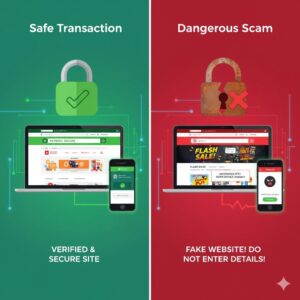Digital Safety: The Scam-Proof Checklist
In today’s hyper-connected world, almost everything is just a click away. From shopping and banking to chatting and working—our lives revolve on the internet.
But alongside all those conveniences, one danger silently grows every day: online scams. These scams don’t knock on your door; they slip silently into your inbox, your phone, or social media feed.
This article is your Scam-Proof Checklist, a simple yet powerful guide to keep you safe in the digital world. Follow these points carefully, and online fraudsters won’t stand a chance.
1. Strong & Smart Passwords Are Your First Shield
In fact, most people use passwords like 123456, password, or their birthdates. These are like unlocked doors for hackers.
How to create scam-proof passwords:
Use at least 12–15 characters.
Mix uppercase, lowercase, numbers, and symbols.
Avoid using personal details like your name, birthday, or pet’s name.
Enable Two-Factor Authentication (2FA) whenever you can.
Pro Tip: Use a password manager instead, rather than writing passwords down in a notebook or saving them to your phone’s gallery.

2. Recognize Phishing Before It Hooks You
The most frequent online scams involve phishing. Typically, these come in through emails, SMS, or fake websites masquerading as banks, courier services, and even companies like Amazon.
Red flags to identify phishing:
“Your account will be blocked” type urgent messages.
Spelling mistakes or suspicious email addresses.
Links that appear weird or slightly misspelled, such as paytm-securee.com.
Attachments from unknown senders.
Golden Rule: Never click on random links or download unknown files. Always open websites by typing the URL manually.
Understanding Digital Safety: Essential Tips to Protect Yourself
3. Secure Your Devices Before Hackers Do
A secure device is like a locked house—hard to break into.
Checklist to secure your devices:
Keep your operating system updated.
Install antivirus or anti-malware.
Avoid third-party cracked apps.
Disable Bluetooth and Wi-Fi when not in use.
Lock your phone/laptop with fingerprint, PIN, or face ID.

4. Stop Oversharing on Social Media
You probably don’t even notice it, but scammers just love your stories on Instagram, Facebook, and WhatsApp. They collect your personal details and use them to reset passwords or trick your friends.
Avoid disclosing
Phone number or email publicly.
Your travel plans or home address.
Photos of ID cards, boarding passes, or bank documents.
Personal fights or emotional breakdowns are used by scammers.
5. Online Shopping? Check Before You Click “Buy Now”
The scammers’ paradise includes fake shopping websites and Instagram stores.
How to shop safely:
Shop only from trusted websites with HTTPS in the address bar.
Check customer reviews and ratings.
Avoid paying the full amount in advance to unknown sellers.
Prefer Cash on Delivery (COD) for new or small online stores.
Bonus Tip: If a deal sounds too good to be true, it probably is.

6. Banking and UPI Safety Rules
UPI and online banking are super convenient but also a favorite target for scammers.
Never make these mistakes:
Sharing OTP with anyone, even if they introduce themselves as a bank employee.
Above, allowing screen-sharing apps like AnyDesk or TeamViewer.
Click on “Request Money” links and enter your UPI PIN.
Always do this:
Regularly check transaction history.
Set daily limits on online payments.
Use official apps (Google Pay, PhonePe, Paytm, or your bank’s app).
7. Public Wi-Fi Isn’t Free: It Costs Your Privacy
Free Wi-Fi in cafes, airports, or metro stations may not be secure.
If you still use it:
Avoid logging into any banking or payment applications.
Do not enter passwords or personal details.
Use VPN for safety if possible.
8. Backup Is Your Best Friend
Imagine this: your phone gets hacked, stolen, or attacked by ransomware. Memories gone, documents gone, contacts gone.
To avoid this heartbreak:
Enable auto-backup for photos, files, and contacts.
Use Google Drive, iCloud, or external hard drives.
Backup once a month at least.

9. Identify Fraudulent Jobs, Lotteries, and Love Scams
Scammers attack where you’re emotionally weakest-money, success, or love.
Fake job scams
“Pay registration fees and get work from home.”
“Earn ₹50,000 per month without skills.”
Lottery scams:
You never applied, still you won? It is a scam.
Asking for tax or processing fees in advance of getting the money = 100% fraud.
Romance scams:
Online relationships wherein the person keeps asking for money for emergencies.
Fake profiles, photo copies, or no video calls.
10. Educate Family—Especially Kids and Parents
You might be aware of online risks, but what about your parents and younger siblings?
Teach them:
Not to share OTP or PIN.
To confirm before forwarding messages.
How to identify fake links and calls.
To call you if they are unsure about anything on the Internet.
11. What To Do If You Get Scammed
Even after being careful, if something goes wrong, take immediate action.

Immediate steps:
Block your bank account or freeze your card.
Change all your passwords.
You can also file a complaint on cybercrime.gov.in or call 1930, a cyber helpline number.
Save the screenshots, messages, and transaction details as proof.
Conclusion: Digital life is like a busy street: beautiful, yet full of risks. You should not be afraid; you need to be aware. This Scam-Proof Checklist is not just a list; it’s your digital survival kit. The more seriously you follow it, the safer your online life will get. Remember: Privacy is not a setting, it’s a habit. Stay alert. Stay updated. Stay scam-proof.
Government Cybersecurity Site Click here

[…] Digital Safety: The Scam-Proof Checklist […]
[…] 7 Steps for Digital Safety: Your Essential Scam-Proof Guide […]